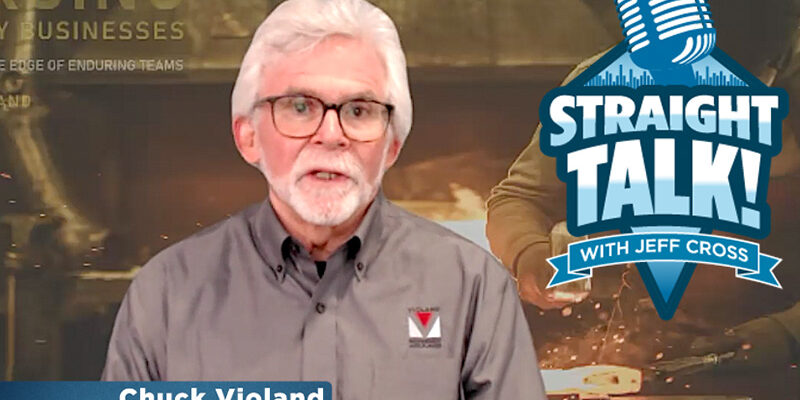The Mistake You’re Making With Your Marketing Message

You might have heard the expression “content is king.” As someone who spent decades as a marketing copywriter and graphic designer, I can tell you from experience, that saying is very true.
In the marketing world, content—both visual and written—makes you or breaks you. This is not a new, digital age phenomenon. I’m here to tell you that it’s always been this way. Marketing and advertising have always been about “the message”—what you are saying to your audience. Essentially, your message reveals the answer to this question: “What should my company be saying to my potential customers?” What should they know? What should we, as a business and a brand, communicate to them for our own success?
And yet, so many businesses are continuously making the same mistake with their content and the message they are sending to their potential customers. Even seasoned veterans in marketing are not immune to this error and have to be reminded not to make this mistake.
The all-important point of view
Your message should not be about you and/or your company. But your content might be saying otherwise.
Take a hard look at your marketing content and materials. What does your marketing say? What message does it send? Is it about what interests your customers, or is it all about your company and, even more so, your own personal thoughts and feeling?
If it’s the latter, that’s not only a mistake — it’s a huge mistake. Because as soon as you make your message about anything other than what your customers need and want to know, you run the sure risk of turning them away. Your content is supposed to act as a “lead magnet.” You’ve now turned it into customer repellant.
I’ve seen this mistake time and time again on my side of creative marketing, when I needed to work with clients and help them craft the messages they would be sending to their audiences. I’ve had requests such as the following—both real, true-life situations.
____________________________
CLIENT: I want my logo to include a tree.
ME: OK. Why is that?
CLIENT: I like trees.
ME: OK. What do trees have to do with what you are offering to your customers?
CLIENT: Nothing. I just like trees. I think they are beautiful.
____________________________
CLIENT: I want the color blue to be used on my website.
ME: OK. Why is that?
CLIENT: I like blue.
ME: OK. Does the color blue evoke a feeling that you want to elicit from your particular customers? Will they respond well to that color?
CLIENT: I don’t know. I didn’t think about it that way. I just know that I like blue. Just use it, OK?
____________________________
I think you can see the pattern.
While we’ve all heard the saying that the client is always right, these clients were so wrong in how they were going about their marketing.
The message your content delivers needs to be—always and forever—about your customers. Even the “about us” page that most websites include is better off talking more about what your business can do for your customers, rather than what your business is or who you are.
Everything you communicate to your customers should address these questions: What do they want? What do they need? How will it be delivered to them? How will they experience your products and services? The answers are the messages that people best respond to and are moved by—but are also the messages that businesses neglect to send.
We are all only human
Despite the truth of what I’ve just outlined, all entrepreneurs can fall into the belief that it is about them and their business. Why is this? Well, I’m not a psychologist, but my university studies suggest that it’s our human egos at work. We all have an ego. While we might not all be clinical narcissists, there is a touch of narcissism in everyone. As humans, we just tend to keep turning things around and making it all about ourselves.
If we then send that “about us” message to our potential customers, we will push them away. Why? For the very same reason that we make this mistake—because they are human too, and in their minds, it’s all about THEM, first and foremost. The message we send needs to confirm that thought and respond to it, rather than compete with it.
You’ve got to remember: The people you are trying to reach with your products and services are just that—people. They, too, are thinking with their human egos. They are asking your business this question: What’s in it for me? If you don’t deliver the right answer, upfront—you’ll lose them.
Don’t bury the lead
In journalism, we have an old saying: “Don’t bury the lead.” The “lead” is the most important part of a news story. You want to tell your readers, right upfront and at the top, the most important information that they’ll want to know when they read your story. If you don’t, they’ll just move on to another article.
The same is very true when attracting prospects for your business. If, for example, they have to scroll past a ton of information or click around your website to find out what it is you offer them—you’ve already lost them. In dealing and consulting with new entrepreneurs and their newly created websites, I noticed a disturbing trend: These sites rarely say on the home page what the company offers. They don’t explain, upfront, what is unique and special about their businesses. They actually make their visitors guess what the business can do for them.
Prospects just aren’t going to work that hard to figure out what your message and, more importantly, what your services or products are. Another important saying is: “A confused mind doesn’t buy.” If people have to decipher your content like a crossword puzzle, they won’t buy from you. They will simply go away.
Adopt the paradigm shift
Unfortunately, a lot of people don’t know enough to even recognize that it’s their written and visual content that’s doing all the damage. Not all content is good content. Also unfortunately, not all entrepreneurs are good writers. And like I’ve already said, even a good writer and marketer has to get out of one’s own head and think with an entirely different perspective. That’s not always easy. It takes a real mind shift to do it. But do it we must, if we want our content to drive sales.
In his book, The 7 Habits of Highly Effective People, Stephen Covey talks about making a “paradigm shift”—looking at things from another perspective—often adopting a viewpoint of a person with whom you might be experiencing a problem. Business owners and marketers have to adopt a paradigm shift as well, even when it’s hard, to help us communicate effectively with our customers and, ultimately, close deals.
Take the time to give this message mind shift a try for yourself and your company. Check the analytics, including your return on investment, and see for yourself if shifting your perspective to that of your potential customer makes a positive difference.












